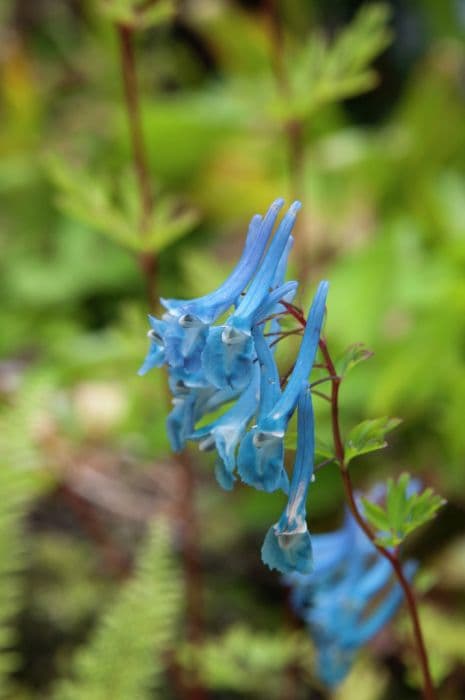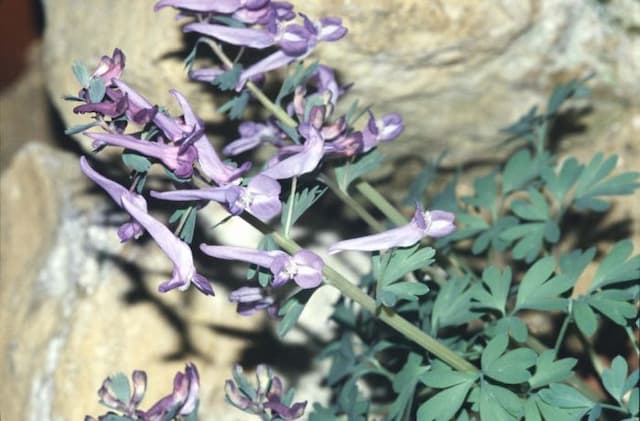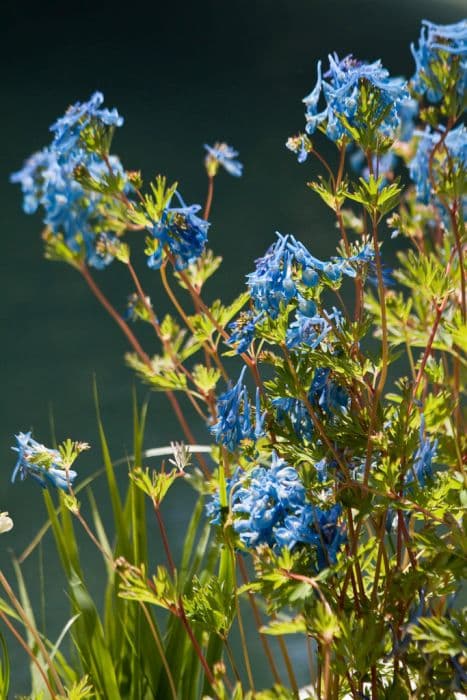Plume Poppy Macleaya cordata (Willd.) R. Br.

ABOUT
Macleaya cordata, commonly known as plume poppy, is a robust, herbaceous perennial known for its distinctive foliage and airy plumes of flowers. The plant features large, rounded, blue-green leaves that have a ruffled texture and are deeply lobed, giving them a unique and decorative appearance. These leaves can become quite sizeable, making them one of the hallmarks of the plume poppy's visual appeal. The stem of plume poppy is sturdy and upright, supporting the substantial foliage and contributing to the plant's commanding presence in a garden setting. During the blooming period, which occurs in summer, the plume poppy produces tall, erect flower spikes. The flowers themselves are tiny, numerous, and are arranged in showy, feathery plumes that can make a visual impact from a distance. They typically exhibit a soft color palette, which may include shades of creamy white to dusty pink, giving an overall impression of a frothy, cloud-like mass atop the sturdy stems. The combination of the large, decorative leaves and feathery flower spikes makes the plume poppy a popular plant for adding texture and a bold architectural element to borders, beds, and gardens that require vertical interest. Despite its common name suggesting a relation to poppies, the plume poppy is distinctive in both its foliage and floral displays, setting it apart from true poppies and contributing to its popularity as an ornamental plant.
About this plant
 Names
NamesSynonyms
Plume Poppy, Bocconia, Tree Celandine, Tree Poppy
Common names
Bocconia cordata Willd., Bocconia japonica Siebold, Bocconia microcarpa Hook. & Arn., Macleaya microcarpa (Hook. & Arn.) Fedde.
 Toxicity
ToxicityTo humans
Plume Poppy, Macleaya cordata, contains several alkaloids like sanguinarine that can be toxic to humans if ingested. If someone eats part of the plant, they may experience symptoms such as stomach pain, vomiting, diarrhea, and in severe cases, it can affect the nervous system leading to symptoms such as tremors and lethargy. Handling the plant can also cause skin irritation in some individuals. It is important to avoid ingesting any part of the plant.
To pets
Plume Poppy, Macleaya cordata, is similarly toxic to pets due to its alkaloid content, including sanguinarine. Ingestion by pets can lead to gastrointestinal distress characterised by symptoms such as drooling, vomiting, and diarrhea. In more severe cases, nervous system signs such as tremors or changes in behavior could occur. Always prevent pets from chewing on or ingesting any part of this plant.
 Characteristics
CharacteristicsLife cycle
Perennials
Foliage type
Deciduous
Color of leaves
Green
Flower color
White
Height
5 ft (1.5 m)
Spread
2 ft (0.6 m)
Plant type
Herb
Hardiness zones
3
Native area
China Japan
Benefits
 General Benefits
General Benefits- Ornamental Value: Macleaya cordata, commonly known as Plume Poppy, is valued for its large, decorative leaves and graceful, plume-like flower spikes that provide aesthetic appeal to gardens and landscapes.
- Drought Tolerance: Plume Poppy is able to withstand periods of drought, making it an excellent choice for xeriscaping and low-water gardens.
- Low Maintenance: This plant requires minimal upkeep once established, as it is generally resistant to pests and diseases and does not require frequent watering or feeding.
- Fast Growth: Plume Poppy has a rapid growth rate, quickly filling in garden spaces and providing structure and visual interest.
- Suitable for Large Spaces: Due to its vigorous growth and tall stature, it is well-suited for filling large spaces or creating backdrops for other plants in garden beds.
- Privacy Screening: Its dense foliage and tall growth habit make Plume Poppy an effective plant for creating privacy screens in the garden or around patios.
- Soil Improvement: This plant can help improve soil structure and fertility as its roots aerate the soil and its decaying leaves add organic matter.
- Attracts Pollinators: The flowers of Plume Poppy attract bees and other pollinators, contributing to the health of the garden ecosystem.
- Erosion Control: With its spreading habit and robust root system, Plume Poppy can help stabilize soil and prevent erosion on slopes or banks.
- Seasonal Interest: As a perennial, it provides season-long interest and can serve as a reliable standby in a perennial border or garden scheme.
 Medical Properties
Medical Properties- Antibacterial: Plume poppy has been used in traditional medicine for its potential antibacterial properties.
- Antifungal: The plant contains compounds that may have antifungal effects.
- Anti-inflammatory: Some components in plume poppy may possess anti-inflammatory qualities.
- Analgesic: There are indications that plume poppy may have pain-relieving properties.
 Air-purifying Qualities
Air-purifying QualitiesThis plant is not specifically known for air purifying qualities.
 Other Uses
Other Uses- Dye Production: Macleaya cordata, commonly known as Plume Poppy, contains natural pigments that can be used to produce a yellow dye for coloring textiles.
- Ornamental Use: With its distinctive plume-like flowers and large leaves, the Plume Poppy can add visual interest to gardens and landscapes.
- Insect Repellent: The extracts of Plume Poppy are known to have insect-repellent properties and can be used to protect other plants from pests.
- Erosion Control: The plant's root system can help stabilize soil and prevent erosion on slopes or in areas with loose earth.
- Natural Fungicide: The compounds found in Plume Poppy have been known to have fungicidal properties and can be used to protect other plants from fungal diseases.
- Adding Biomass: Plume Poppy can be grown as a green manure crop, contributing organic matter to the soil when chopped and turned under.
- Livestock Fodder: In some areas, the leaves of Plume Poppy may be used as fodder for livestock, though it is not commonly practiced due to its potential toxicity.
- Botanical Research: It can be utilized for educational purposes and research in botany to study plant morphology and adaptations.
- Photography and Art: Because of its unique and attractive flower structure, Plume Poppy is often used as a subject in photography and botanical art.
- Privacy Screening: Due to its height and dense foliage, the plant can be used to create a natural privacy screen in gardens and parks.
Interesting Facts
 Feng Shui
Feng ShuiThe plant Macleaya cordata is not used in Feng Shui practice.
 Zodiac Sign Compitability
Zodiac Sign CompitabilityThe plant Macleaya cordata is not used in astrology practice.
 Plant Symbolism
Plant Symbolism- Detachment: Macleaya cordata, commonly known as Plume Poppy, has a growth pattern where its large leaves and plumes can stand apart from each other, symbolizing a sense of independence and detachment from worldly concerns.
- Protection: The plant contains several alkaloids that make it unpalatable to many herbivores, which can represent a symbol of protection and natural defense mechanisms.
- Peace: The soft, feathery plumes of the Plume Poppy, especially when blowing gently in the wind, can evoke a sense of tranquility and peace.
- Isolation: Due to its tendency to grow in clusters but with individual plants spaced apart, the Plume Poppy can represent isolation or standing out in a crowd.
 Water
WaterPlume poppy or Macleaya cordata should be watered deeply whenever the top inch of soil feels dry, which may roughly equate to once a week during active growth periods and more sparingly during dormancy. The soil should be kept evenly moist but not waterlogged. Typically, watering with 1 to 1.5 gallons per plant each time should suffice, depending on the size of the plant and environmental conditions. Overwatering can lead to root rot, so it is essential to ensure good drainage. During the winter or dormant season, reduce watering frequency to every few weeks, just enough to prevent the soil from completely drying out.
 Light
LightPlume poppy thrives best in full sun to partial shade conditions. Ideal placement is a location where the plant will receive at least six hours of direct sunlight daily, but some afternoon shade can be beneficial in hot climates. The more sunlight Macleaya cordata receives, the more robust its growth will be, though too much intense sun may harm the plant.
 Temperature
TemperaturePlume poppy prefers temperatures ranging between 50°F and 75°F but can tolerate a wider range. Maximum cold tolerance hovers around 20°F, while it can handle short periods of higher temperatures up to 90°F or slightly above. Ideal growth occurs within the moderate temperature range where it is neither too hot nor freezing, maintaining a balance for healthy growth.
 Pruning
PruningPlume poppy should be pruned to remove spent flower spikes and encourage additional blooming. Pruning can also help maintain the desired shape and size of the plant. Cut back the stems to a node or a side shoot after flowering has finished, typically in late summer or early fall. The plant can also be cut back to ground level in late winter or early spring to allow for fresh growth.
 Cleaning
CleaningAs needed
 Soil
SoilPlume Poppy (Macleaya cordata) prefers well-draining soil enriched with organic matter, with a pH range of 5.5 to 7.5. A good soil mix might include garden soil, compost, peat, and perlite to ensure proper drainage and fertility.
 Repotting
RepottingPlume Poppy generally does not require frequent repotting as it is a spreading perennial. It may be divided or repotted every few years to manage its size or if it outgrows its current location.
 Humidity & Misting
Humidity & MistingPlume Poppy thrives in average outdoor humidity levels and does not require specific humidity conditions to grow well.
 Suitable locations
Suitable locationsIndoor
Use bright indirect light, large container, and well-draining soil.
Outdoor
Plant in full sun to dappled shade, fertile, well-drained soil.
Hardiness zone
3-9 USDA
 Life cycle
Life cyclePlume Poppy (Macleaya cordata) begins its life as a hardy perennial from seed or rhizome division, often germinating in early spring. Seedlings develop into a rosette of leaves before sending up tall flowering stems in late spring to early summer. The plant exhibits rapid vegetative growth and produces large, deeply-lobed leaves, which are distinctive for their bluish-green color and silvery-white undersides. By mid to late summer, the Plume Poppy reaches its reproductive stage, displaying small, white to pale pink flowers in airy, plume-like panicles that can reach up to 8 feet in height. Once pollinated, the flowers give way to small, capsule-like fruits containing numerous tiny seeds that are dispersed by wind in late summer to fall. The plant dies back to the ground after frost, with the roots surviving winter to regenerate the next spring.
 Propogation
PropogationPropogation time
Spring to early summer
Macleaya cordata, commonly known as Plume Poppy, is a robust perennial that can be propagated most popularly by division or from seed. The most favored method is division, which should ideally be done in the early spring as new growth appears. To propagate by division, carefully dig up an established plant and use a sharp spade or knife to cut the root clump into smaller sections, ensuring that each section has at least one eye or bud. These divisions should then be replanted immediately at the same depth they were growing at previously, spaced about 2 to 3 feet apart to allow for ample growth. Water the newly planted divisions thoroughly to help establish them. This straightforward technique quickly produces new plants that are true to the parent and will start filling in your garden space in no time.









